Two of the principal fronts of Sion House command very beautiful scenery; for even the Thames itself appears to belong to the gardens, which are separated into two parts by a serpentine river that communicates with the Thames.
The gardens were principally laid out by Brown: they have, however, been lately improved and re-arranged; and the kitchen-garden is almost unequalled by any thing in the kingdom. Here is a range of hothouses upwards of 400 feet in length, constructed of metal, even to the wall-plates, the doors, and framing of the sashes; the whole being glazed with plate-glass. It is impossible for us to describe the extent and completeness of these improvements, connected with which, Mr. Loudon observes—“nothing can be more gratifying than to see a nobleman employing a part of his income in so judicious and spirited a manner."[1]
[1] Mr Loudon promises an
account of these improvements for the next
number
of his valuable Gardener’s Magazine.
* * * * *
RETROSPECTIVE GLEANINGS.
* * * * *
MONKISH VERSES.
(For the Mirror.)
Mirror, vol. xii. pp. 98, 165.
The following is said to have been the epitaph on
the tomb of Fair
Rosamond, at Godstow:—
Hic jacet in tomba, Rosamundae non
Rosamundi,
Non redolet sed olet quae redolere solet.
TRANSLATED.
Within this tomb lies the world’s
fairest rose;
Whose scent now charms not, but offends
the nose.
Mirror, vol. xiii. p. 98.
The couplet on York Minster, translated.
As of all flowers the rose is still the
sweetest,
So of all churches this is the completest.
On the stone in the coronation chair in Westminster Abbey.
Ni fallat fatum, Scoti quocunque loquitur,
Inveniant lapidem, regnare teneter ibidem.




